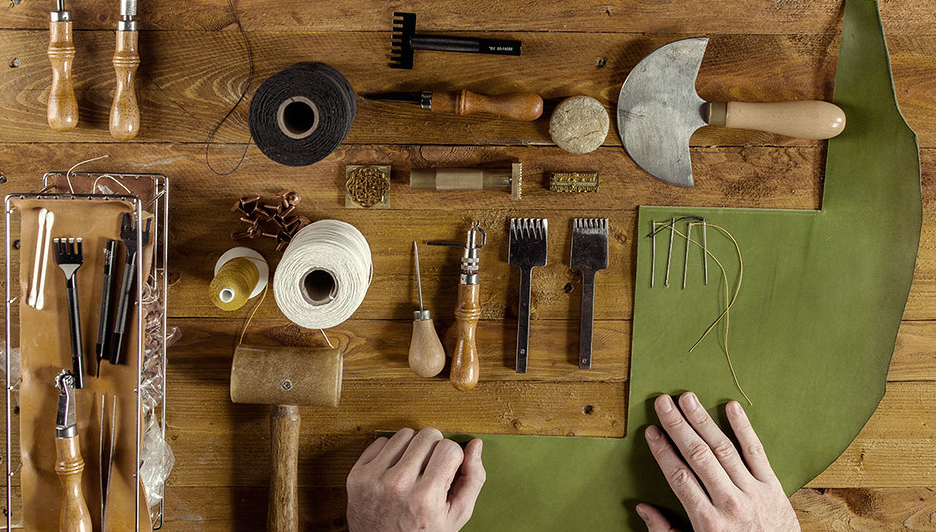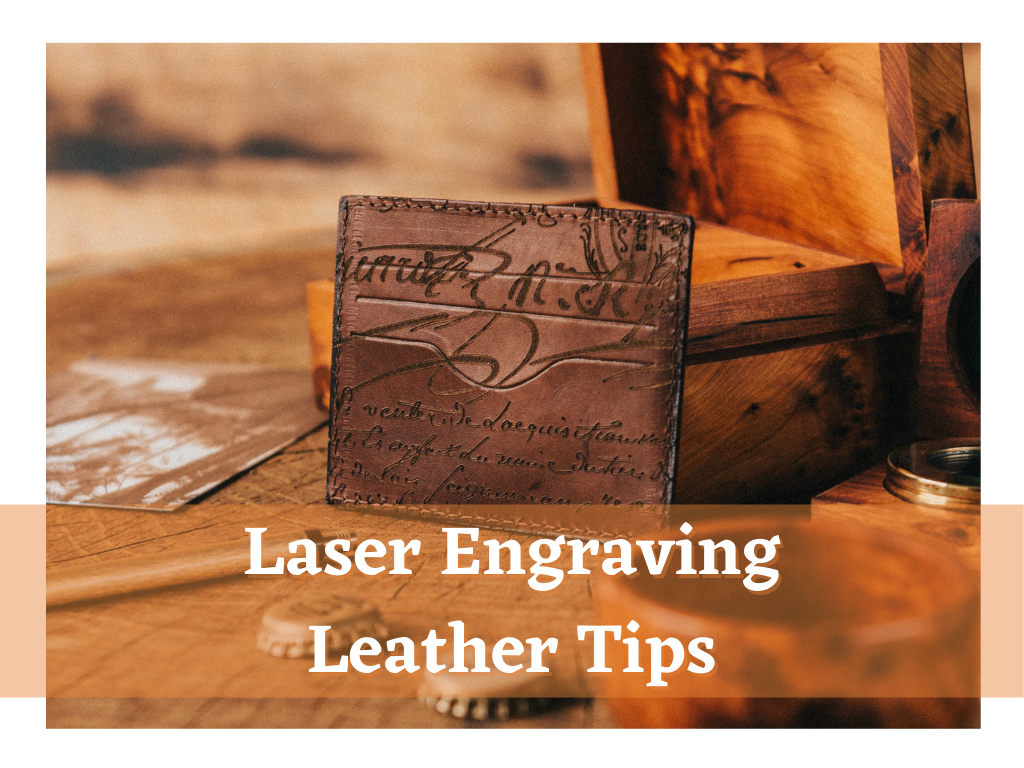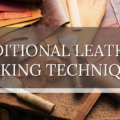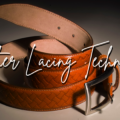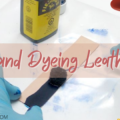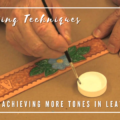Leatherworking always involves leather skiving. It may be in making leather belts, leather shoes, leather bags, leather wallets, etc. This is because skiving helps an effective leather crafting in a different sense. Skiving includes leather designing (particularly the accessories attachments), smooth stitching process (especially the thick leathers), effective leather gluing, and avoiding an uncomfortable loop or bulky part of the item. With its various uses in different leather items, types of skiving came about. These are styles you can choose from for a more fantastic output.
What are the types of skiving? The type of skiving intended for a specific application in various leather projects is entire skiving and partial skiving that requires appropriate equipment and machine. In contrast, minor skiving can be done by hand with sharp cutting tools.
Skiving is not just a simple slicing, shaving, or thinning off the leather. It is done for “fancy leather goods making,” and for this to work effectively; specific skiving should be applied. When I first started skiving my leather projects, I was overwhelmed but challenged because of its difficulty for a beginner. However, being able to pull it off was fulfilling and improved much of my outputs. Learning these techniques properly and appropriate types are crucial because skiving cannot be undone on the leather. You can use this time at home due to COVID-19 to work more on that skiving skills. In this article, I will share the different types of leather skiving, which is undoubtedly helpful for beginner leatherworkers.
Entire Whole Skiving Perfect For Various Projects
Image Source: “2015_09_24_Luxury_Leather_Africa_JPEG_RESIZED_0008” by makeitkenya is marked with CC PDM 1.0
If you are a leatherworker who creates various leather items that require several skiving procedures, then this is for you. This type of skiving, along with the ideal skiving machine, is used in many leatherworking companies so that various arts of leather crafting will be made accurately and perfectly.
Getting To Know What It Is
From the word itself, this is the type of skiving where the crafter thins a large area or the entire leather. For this reason, a piece of large skiving equipment is used, which requires a larger leatherworking area.
The skiving machine used in this entire whole skiving is costly. Some leatherworkers go to the nearest leather market to use this kind of equipment. In Korea, leather markets like Shinseol-dong have this kind of equipment where people can use it. Some leather schools have this kind of skiving equipment and some individual leathercrafters use it. You can learn this type of skiving formally in a school or on your own through blogs or online videos.
Why It Is Used
This entire skiving is used in leatherworking, like in making bags, pouches, belts, and other small or large leather products. Since making high-quality leather bags requires cowhide type of leather, usually five mm in thickness, the entire skiving is applied. Manipulation of leather’s thickness needs careful skills but can be learned through practice and constant application just like any other process.
Not just in creating leather bags that this cowhide leather is skive, but it is usually split and skived off because of its thickness. In some cases (particularly the thick type of leather), leather projects might not be produced without the entire whole skiving.
Advantages of Using This Type
Leather crafters can apply various art in any leather item by skiving the leather’s original thickness. Any desired leather item is possible. Its machine will produce an even and accurate leather skiving, and its equipment offers a sophisticated result of leather skiving. Of course, it uses a long-lasting device which also means a bang for the buck. You might spend a lot at first when you purchase but definitely worth it in the long run.
Downsides of This Type
The machine is costly and some DIY leathercrafters might not afford it. It is also very work space-consuming because of its large and bulky size. Its skiving machine is difficult to use because it has several parts/ knots that need adjustment before use.
Partial Part Skiving Ideal For Getting A Portion
Image Source: “2015_09_24_Luxury_Leather_Africa_JPEG_RESIZED_0003” by makeitkenya is marked with CC PDM 1.0
Another essential type of leather skiving is partial part skiving. This type of leather skiving is the exact opposite of the entire whole skiving that was mentioned above. Understanding the proper way of partial part skiving can help your leather crafting become practical, fabulous, and look aesthetic.
Getting To Know What It Is
This type of leather skiving will only slice and thin a partial part of the leather area. It is used in most leather items processes that require folding, bending, etc. It skives specific leather-based areas upon its design, and you can use tons of skiving machines in partial skiving.
Why It Is Used
It is used for numerous reasons in leathercraft into perfect, luxurious leather products possible. You can do it by putting designs and accessories on the leather item. Partial skiving is commonly used in skiving thin leather for fashion purposes. It is used for light leather since a partial part will be sliced for the leather surface’s evenness in making a folding portion of the leather belt and many other leather items.
Advantages of Using This Type
It is straightforward to use because it uses a machine to do the work. It is a mechanical leather skiving that works on high precision for a specific part of the leather. Different skiving machines are into this type of leather skiving. There are several affordable skiving machines, and they work very well on different kinds of leather.
The machine used in partial skiving is not large and bulky, which means a-not-spaced-consuming one. Its machine can be purchased by anyone interested in leatherworking for a friendly price. Like the machine used in entire skiving, this too is a long-lasting one. You can opt to upgrade its parts or purchase a new one.
Downsides of Using This
The machine used in this type of leather skiving needs much maintenance, and some machines are expensive. The device is quite tricky to operate for beginners. Some beginners tend to skive the leather portion that is not part of the leather surface thinning area. Its machine requires several adjustments for the different desired thickness of the leather. But worry not, since it’s usually pre-set when purchased.
Hand Skiving For An Intimate Leatherworking Experience
Image Source: “Shoemaker cutting leather to form” by Ivan Radic is licensed under CC BY 2.0
If you are a beginner, leathercrafter, leather DIY maker, and anyone who has the hobby and passion of creating arts with leather must learn and understand hand skiving. This is an essential skill in leatherworking because it will take you to a higher form of the art of leather crafting. It will help the simple leather designs to the complex structures by just hand skiving the leather. Moreover, hand skiving requires standard tools that you can find at home, thereby inexpensive and convenient.
The Whats, Whens, and Whys of A Raw Edge Skive
Raw edge skive is one of the most used in leather skiving, for it simply reduces the thickness of the leather’s flesh side. The leather becomes clean through this type of skiving due to the removed loose fibers in the edges and still durable after the process.
It also promotes convenience to the stitching process, reducing the leather subject’s edge substance to sewing. This type of skiving is applied when leather needs to be stitched close to the edge. This raw edge skive has two subtypes as the open and closed raw edge skive that function distinctively. Both are doable for beginners and you can choose what type is perfect for your project.
The open raw edge skive is usually applied in heavy leathers, wherein the upper section needs to be left with raw edges. This is used even if the leather edges have undergone any treatment (to make them smooth and uniform looking) or have not been treated. Its skive depth is usually a third of the thickness of the leather, while its width must not exceed the edge stitching distance.
The closed raw edge skive is used to remove excess bulkiness and uncomfortable loops of the secure seams of leather to have a smooth and uniform finishing look. Its depth is ⅔ of the thickness of the leather, its width is about 2-3 mm, and a steep angle which is 30-50 degrees is made. Yet, their measurements change upon the thickness of the leather.
All of these can be done through hand skiving and machine skiving. There are many affordable, handy tools used in hand skiving that require honing and stropping maintenance only. These hand skiving tools are long-lasting and can be used in leather cutting.
It is very much applicable to every leather crafting process like in shoemaking, belt making, and others. This will become one of the necessary skills in leather crafting when applied often. It is used both in DIY leather crafting and commercial leatherworking. It is difficult for beginners because they might cut the leather instead of reducing it which will require practice.
The raw edge hand skiving is difficult, especially the open raw edge skive. Uniform and even leather skived surfaces in this raw edge type of skiving are difficult for beginners. The hand skiving process in raw edge skive is time-consuming but doable.
The Whats, Whens, and Whys of A Folded Skive
In most cases, the leather’s edge is folded to make them look neat, clean, and professional. However, folding the edge will produce a bulky part of the leather and become challenging to stitch, especially the thick leathers. This is why folding skives, which is another type of leather skiving, can be done.
This type of leather skiving has the primary purpose of reducing the leather edge thickness that needs folding. Once the edge is skived, the leather will have a similar and even thickness to the original leather. This type of leather skiving is commonly used in making aprons, caps, etc.
A folded skive has two kinds of leather skiving, such as the hollow fold skive and the shallow or wedge fold skive. The hollow fold skive is used in heavy and thick leathers. Its skive depth is half of the leather thickness, while the width is twice its folding margin with the one mm roll-over allowance.
The shallow or wedge fold skive is used in thin and soft leathers having a 35-degree angle of its depth skive and with a width of twice the folding margin. It is applicable for both hands skiving tools and skiving machines.
The hand skiving tools used in this type of skiving are economical, and you can even find them both online and in physical stores. Some of its hand skiving tools are not only for leather skiving but also in cutting.
The hand skiving tools have low-cost maintenance, which only requires honing, stropping, and replacing blades. Many skiving machines are available for this type of skiving that will do an accurate and perfect thinning mechanically. This type of skiving is applicable in every process of various leather items.
These folding skives for hand skiving are not only usable in DIY (Do-It-Your Own) leather crafting as well as in commercial leatherworking. Learning this folding skive will help you gain the necessary skills in leather crafting.
It is difficult for beginners, especially in making even leather skives. For the beginners in hand skiving, the leather might be ruined or cut, especially the thin and soft leathers. It takes several practices for the beginners to practice this folding skive by hand. Hand skiving operation in folding skives is time-consuming.
The Whats, Whens, and Whys of An Underlay Skive
Underlay skive simply means skiving underlay two pieces of overlapping leather stitching. This is usually done for lapped seams on the flesh side of the leather so that there would be no loops, bulkiness, bumps that will cause problems during stitching. The underlay skive happens typically on the bottom of the flesh side of the leather.
This underlay skive application has an exception, especially in leather footwear, because it is skive on the grain side to make them look good on the inside. Its skiving depth must narrow down the most refined possible edge of the leather to avoid a print-through.
A stitching mark is necessary for this type of skiving before the underlay skiving because its width must be two to three millimeters behind the stitch marking line or the underlay margin. For this reason, the first row of stitching is in full-thickness so that its materials can give strength to the leather seam. For leather that is 0.8 mm thick and above, it requires skiving half of the original substance.
This is applied in the side seams on-court shoes, vamp with the apron, vamp with cap, quarter to vamp, three quarter cut lining, etc. Underlay skiving can be done by hand skiving tools and skiving machines.
The hand skiving tools used in the underlay skive are not expensive and only require maintenance like honing and changing blades which are sometimes included when purchasing skiving tools like knives.
The needed tools to perform the underlay skive are found both in physical leather stores and online stores. Its hand skiving tools are handy and comfortable. Working with the underlay skive does not require a big area because its tools are not large hence not spaced consuming. It is applied to different leather crafting items. It is one of the essential skills that a leather crafter must-have. It can be used in leatherworking industries and also in your DIY leather crafting.
Similar to the other types of leather hand skiving, the underlay skive is also tricky for beginners. Some beginners might cut the underlay leather instead of reducing it. Underlay with the use of hand skiving tools may require more time but will turn out great once executed properly.
Conclusion
Leather skiving can be done with the use of machines and hand skiving tools. The use of machines eases the time and effort spent on skiving. Hand skiving, however, hones your skill in skiving manually, making you ready for more significant projects. These leather skiving types are essential skills needed in leather crafting that will help you create fabulous leather items. You can use any of these to match the projects you are working on. In no time, you will be a master in leather skiving.
